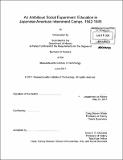| dc.contributor.advisor | Craig Steven Wilder. | en_US |
| dc.contributor.author | Su, Christopher (Christopher Thomas) | en_US |
| dc.contributor.other | Massachusetts Institute of Technology. School of Humanities, Arts, and Social Sciences. History Section. | en_US |
| dc.coverage.spatial | n-us--- a-ja--- | en_US |
| dc.date.accessioned | 2011-08-30T15:46:07Z | |
| dc.date.available | 2011-08-30T15:46:07Z | |
| dc.date.copyright | 2011 | en_US |
| dc.date.issued | 2011 | en_US |
| dc.identifier.uri | http://hdl.handle.net/1721.1/65525 | |
| dc.description | Thesis (S.B.)--Massachusetts Institute of Technology, Dept. of Humanities, 2011. | en_US |
| dc.description | Page 6 missing. Cataloged from PDF version of thesis. | en_US |
| dc.description | Includes bibliographical references (p. 57-58). | en_US |
| dc.description.abstract | Introduction: Alice Nakamura, a senior of the Class of 1943 at Rohwer Center High School in Arkansas, read these words at the conclusion to her graduation speech. Substantively, it sounds like any other reflection on self-identity by a second-generation immigrant. In reality, Alice's speech stands out because it was delivered from a school located behind barbed wire, where the United States government had detained her because of her Japanese ancestry. Between 1942 and 1945, the United States government removed more than 110,000 individuals of Japanese ancestry residing on the west coast to remote relocation centers located in the barren mountainous states of the American west. Deprived of their freedom, these internees found themselves faced with the challenge of carrying on their everyday lives while surrounded by barbed wire. Parents concerned about the educational prospects of their children pushed for the development of primary and secondary schools, which the administrations provided. Adults seeking to occupy their time after work and alleviate boredom initiated education programs taught by internees who possessed relevant technical abilities and academic credentials. Despite the limited freedom and control the internees had over their squalid living conditions, educational programs emerged as one area in which they were able to establish a voice for themselves and collaborate with camp authorities. Due to the wartime shortage of teachers, many young Japanese teachers staffed the primary and secondary schools. The internees completely ran the Adult Education program with only perfunctory oversight from the camp administrations. In return for this degree of autonomy, the WRA requested the establishment of Americanization classes in all levels of camp schooling. These classes focused on the dissemination of American values and preparation for life after the war. Internees had mixed reactions to these government-mandated requirements but many valuable lessons came out of these classes. Primary and secondary students had an intensely personal experience learning about democracy inside barbed wire. As these students went on to attend colleges and find jobs after internment, they took these experiences with them and crafted new and deeply personal definitions of being an American citizen. The Adult Education programs gave internees English skills and new cultural knowledge that they used in their post-war communities and to communicate with their own children. Despite the horrid conditions that the Japanese experienced in the internment camps, the education program created relatively positive interactions between the internees and the camp authorities. Although suffering from supply shortages and a high variance in teaching quality, the educational programs challenged internees to think about democracy and what it means to live in America. Japanese internees provided staffing for these programs and worked with the camp administrators to implementing the curriculums, which allowed a degree of self-governance, an uneasy feat in government-controlled wartime internment centers. The Japanese-American internment process began on February 19, 1942, when President Franklin D. Roosevelt signed Executive Order 9066, authorizing the military to create special areas within the United States from which "any and all" persons may be excluded. The exclusion order applied to both citizens and aliens, meaning that the government intended to remove both Japanese immigrants and Japanese Americans. The former are issei, a term meaning "first-generation" in Japanese, and the latter are nisei, "second-generation." Throughout the internment process, more than 110,000 individuals of Japanese-ancestry were excluded from the zones of exclusion, often forced to sell their belongings, and relocated to barren camps established in the interior of the United States. The internment process had no pretenses of kindness - following Pearl Harbor, propaganda posters depicting Japanese as apes and other savage animals were widely distributed, and racist sentiments were openly published and distributed through the press. A selection from a San Francisco newspaper derided the Japanese during the onset of the internment process: "Herd 'em up, pack 'em off and give 'em the inside room in the badlands. [...] Let us have no patience with the enemy or with anyone whose veins carry his blood [...] I hate the Japanese." A propaganda poster distributed in 1943 titled, "How to Spot a Jap," described a Japanese as having "buck teeth" and being unable to smile because he "expect[s] to be shot...and is very unhappy about the whole thing." Even Americans from the interior expressed hostility. ... | en_US |
| dc.format.extent | 60 p. | en_US |
| dc.language.iso | eng | en_US |
| dc.publisher | Massachusetts Institute of Technology | en_US |
| dc.rights | M.I.T. theses are protected by
copyright. They may be viewed from this source for any purpose, but
reproduction or distribution in any format is prohibited without written
permission. See provided URL for inquiries about permission. | en_US |
| dc.rights.uri | http://dspace.mit.edu/handle/1721.1/7582 | en_US |
| dc.subject | Humanities, Arts, and Social Sciences. History Section. | en_US |
| dc.title | An Ambitious Social Experiment: Education in Japanese-American Internment Camps, 1942-1945 by Christopher Su. | en_US |
| dc.type | Thesis | en_US |
| dc.description.degree | S.B. | en_US |
| dc.contributor.department | Massachusetts Institute of Technology. History Section | en_US |
| dc.contributor.department | Massachusetts Institute of Technology. Department of Humanities | |
| dc.identifier.oclc | 746805717 | en_US |
